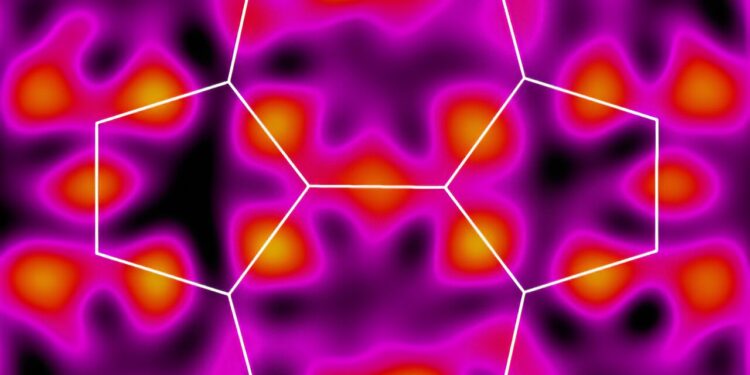X-ray analysis of single crystals captures the two protons (bright yellow spots, top and bottom) moving between two positions on the molecule. Credit: Royal Society of Chemistry, CC BY 3.0 DEED
RIKEN chemists have developed a method for manufacturing synthetic derivatives of the natural dye indigo that does not require harsh conditions. The discovery could inspire advances in electronic devices, including light-sensitive gadgets and stretchable biomedical sensors.
Semiconductors based on organic molecules are attracting a lot of interest because, unlike conventional rigid silicon-based semiconductors, they could be flexible, ductile and lightweight, opening new possibilities for semiconductor device design .
Organic molecules also have the advantage of producing a wide range of structures. “Organic semiconductors have a flexible molecular design, which allows them to adopt new functionalities,” says Keisuke Tajima of the RIKEN Center for Emerging Materials Science, who led the research published in Chemical science.
To explore this potential for enhanced electronic function through molecular design, Tajima and his team studied an indigo-related molecule called 3,3-dihydroxy-2,2-biindan-1,1-dione (BIT). “This project started with a simple question: can protons and electrons move together in the solid state?” Tajima said.
Proton-coupled electron transfer, in which the movement of electrons is linked to that of protons, is often considered essential for achieving efficient electron transfer in biological systems. If it could be incorporated into solid organic materials, it could lead to semiconductors with unique dynamic properties. However, until now, no solid material exhibiting proton-coupled electron transfer has been demonstrated.
Tajima and his team discovered that BIT and its derivatives undergo unusual rearrangements in their structures involving double proton transfer, which could give them unique capabilities as electronic functional materials.
Tajima identified BIT and its derivatives as promising materials for the transfer of proton-coupled electrons in the solid state, because the molecule incorporates two protons that appear ideally positioned to move from one position to another during transfer. of electrons.
Until now, achieving BIT required harsh conditions that significantly limited the range of derivative products that could be made. Team members developed a room temperature approach that enabled the synthesis of several BIT derivatives under much milder conditions.
With the BIT derivatives in hand, the team explored the properties of the molecules. “The most difficult part was proving that the BIT protons undergo proton transfer between molecules in the solid state,” says Tajima. Working with RIKEN experts in X-ray crystallography and solid-state nuclear magnetic resonance (NMR), the team demonstrated that the two protons quickly exchange positions.
Calculations suggest that proton transfer is indeed coupled to charge transport; The team’s next goal is to experimentally confirm this coupling. “We don’t know if the presence of a proton will improve charge transport, but in terms of fundamental physics, it could open up interesting avenues,” says Tajima.
More information:
Kyohei Nakano et al, Synthesis of 3,3′-dihydroxy-2,2′-diindan-1,1′-dione derivatives for tautomeric organic semiconductors exhibiting double intramolecular proton transfer, Chemical science (2023). DOI: 10.1039/D3SC04125E
Quote: A method for making a synthetic derivative of natural indigo could inspire future electronic devices (February 1, 2024) retrieved February 1, 2024 from
This document is subject to copyright. Except for fair use for private study or research purposes, no part may be reproduced without written permission. The content is provided for information only.



